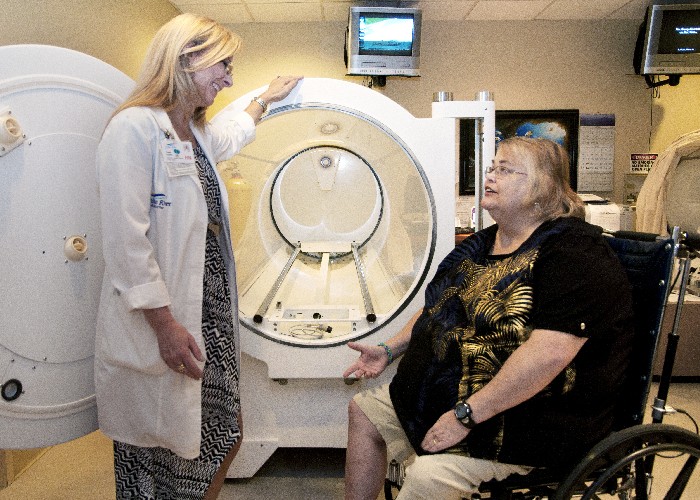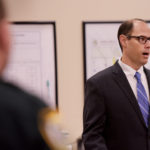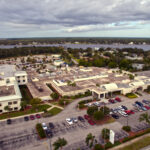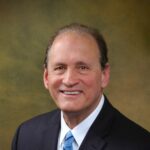
One unlucky penny could have cost Mary Fitz her foot.
Back home in Pennsylvania, Fitz thought she’d kicked a penny under her bed and went about her busy day – 10 hours running errands. Only when she took her shoes and socks off that night did she realize the coin had stuck to the bottom of her foot.
“Do you always wear a penny on your foot?” her husband joked.
But it was no laughing matter. Fitz, who owns a home in Vero Beach, developed a pressure ulcer on her foot, received treatment including surgery to battle the infection, then came to town for a week’s visit, thinking she was on the mend.
Instead her foot swelled, “an angry looking purplish-blue” spread, and she ended up in the emergency room of Indian River Medical Center, then the hospital’s Wound Healing Center and Hyperbaric Medicine.
A diabetic, she was suffering from a serious ulcer that required an extraordinary response: 60 days of treatment in a hyperbaric oxygen chamber, where for two hours each day she breathed pure oxygen under pressure.
These chambers are at the leading edge of medical care for certain chronic wounds, just one of the latest techniques for wounds that don’t heal as they should.
A normal wound, says Dr. David Haile, a podiatrist who is on staff at both IRMC and Sebastian River Medical Center, heals in two to three weeks on average. A chronic wound is older than six weeks, and can be serious business.
Complications from diabetes, circulatory problems or pressure on the wound are among the reasons for healing that comes late or not at all, without intervention. And when it comes to infected wounds, says Haile, some bacteria are becoming resistant to commonly used antibiotics. “This makes medical treatment more difficult,” Dr. Haile explained.
In one promising technique for specific conditions, Dermagraft, an FDA-approved skin substitute, is used to help close persistent wounds from diabetic foot ulcers. Human cells are placed on a dissolvable mesh, which is gradually absorbed as new cells develop and replace damaged skin. It’s being investigated for wider applications, too.
In hyperbaric oxygen therapy, long used for decompression sickness for scuba divers, patients with wounds that won’t heal from diabetes or a radiation injury breathe pure oxygen in a pressurized room. The lungs gather much more oxygen than would be possible without the pressure, and as the blood carries the oxygen through the body, it stimulates healing. Both IRMC and SRMC offer hyperbaric oxygen therapy.
Fitz said she was “scared to death” her first day of treatment in the chamber but soon learned to relax and pass the time reading, watching TV or listening to music. Just last week, she was able to remove her bandage without another one going on.
That penny could have cost her a foot, even her life.
“They gave me hope,” Fitz said of the Wound Healing Center in Vero Beach. “When I thought I’d end up losing my foot, they kept me positive.”
Diane Smith, 62, of Sebastian, got sarcoma and had radiation before surgery to shrink and consolidate a tumor in her right thigh. The surgery left a gaping hole that was 10-inches long and she could see her femur. She also suffered a post-operative infection in the wound.
She spends 20 hours a week at the IRMC Wound Healing Center, two hours each session is spent in the hyperbaric tank.
She walks into it, lies down, and does “tricks to pop my ears so I feel comfortable.”
“I don’t feel claustrophobic. There’s glass around it, except the part you lie on. I was afraid it would freak me out, but it’s become nice and relaxing nap time.”
She is slated for 60 hyperbaric sessions.
“This huge wound I have is pretty remarkable. I have the proper treatments because people at the center know what they are doing, giving excellent instruction.”
“Instead of lying here and saying, ‘poor me,’ it’s a motivation to get up and go to the wound center.”
IRMC Wound Healing Center recently got a Distinction Award. The center, which provides hospital-based outpatient wound care services, has a healing rate of 91 percent in 16 weeks or less, higher than the national average.
The center is staffed with a team of doctors, nurses and therapists all dedicated to healing chronic wounds. The multidisciplinary professional staff receives extensive training in wound healing and works together with nine staff physicians to heal wounds in an effective manner.
The award was given based on the following requirements:
_Patient satisfaction greater than or equal to 92 percent; the wound center’s rating is 98 percent.
_Healing rate greater than or equal to 91 percent; the wound center has a 96-98 percent average.
_Outlier Rate (patients who are not healing after 16 weeks) less than 19 percent; it is 12 percent at the center.
_Median days to heal is less than or equal to 30; the center is 21 to 24 days on average.
Carrie Duprey, program director of IRMC’s Wound Healing Center said there were 1,800 visits last quarter.
“Wound care has come a long way in the last 10 years with new biological products and with advancement in hyperbarics in healing,” she said. “People who don’t heal fast, and are prone to infections aren’t getting infections as badly and losing limbs due to poor blood flow.”
“Hyperbarics is the big thing,” she added. “This has been the one treatment we now have that has pushed us forward in wound healing.”
In 2013, SRMC’s Center for Wound Care and Hyperbaric Medicine had nearly 5,000 patients visit.
Patients end up at wound care centers for various reasons including bone infections; diabetic foot and leg wounds; recurring wounds; surgical wounds; ulcers, including ischemic, pressure and venous stasis; wounds association with radiation therapy; and other conditions such as bites and infections.
Haile says the basic treatment modalities include: appropriate debridement; decrease in bacterial bioburden (the number of bacteria living on a surface that has not be sterilized), both with topical and systemic antibiotics; off-loading of any pressure that is affecting the wound; correction of biomechanical deformities through surgery; skin grafting and flap advancement; advanced dressing modalities.






